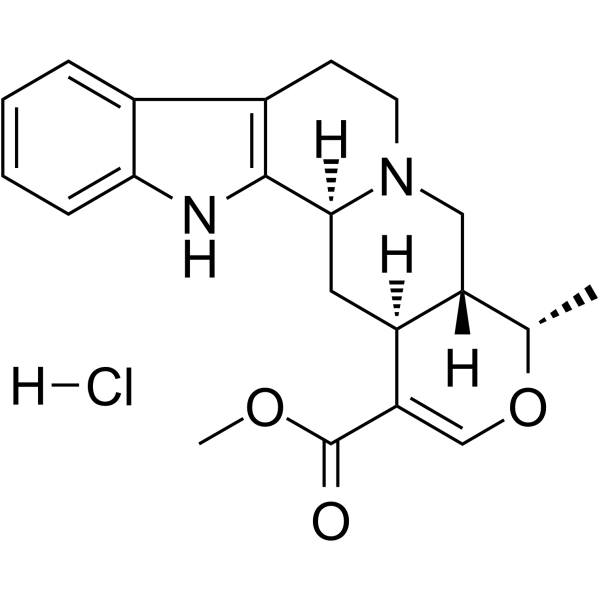Ajmalicine hydrochloride
Modify Date: 2025-08-20 20:34:30

Ajmalicine hydrochloride structure
|
Common Name | Ajmalicine hydrochloride | ||
|---|---|---|---|---|
| CAS Number | 4373-34-6 | Molecular Weight | 352.427 | |
| Density | 1.3±0.1 g/cm3 | Boiling Point | 524.0±50.0 °C at 760 mmHg | |
| Molecular Formula | C21H24N2O3 | Melting Point | 275-300ºC | |
| MSDS | N/A | Flash Point | 270.7±30.1 °C | |
Use of Ajmalicine hydrochlorideAjmalicine (Raubasine) hydrochloride is a potent adrenolytic agent which preferentially blocks α1-adrenoceptor. Ajmalicine hydrochloride is an reversible but non-competitive nicotine receptor full inhibitor, with an IC50 of 72.3 μM. Ajmalicine hydrochloride also can be used as anti-hypertensive, and serpentine, with sedative activity[1][2]. |
| Name | ajmalicine hydrochloride |
|---|---|
| Synonym | More Synonyms |
| Description | Ajmalicine (Raubasine) hydrochloride is a potent adrenolytic agent which preferentially blocks α1-adrenoceptor. Ajmalicine hydrochloride is an reversible but non-competitive nicotine receptor full inhibitor, with an IC50 of 72.3 μM. Ajmalicine hydrochloride also can be used as anti-hypertensive, and serpentine, with sedative activity[1][2]. |
|---|---|
| Related Catalog | |
| Target |
α1-adrenergic receptor α2-adrenergic receptor |
| In Vitro | Ajmalicine hydrochloride preferentially blocks α1-adrenoceptor than α2-adrenoceptor[1]. Ajmalicine hydrochloride inhibits contractions in a concentration-dependent manner (IC50=72.3 ± 22.5 μM)[2]. Ajmalicine hydrochloride acts preferentially at postsynaptic sites, competitively antagonizes the effect of noradrenaline on postsynaptic alpha-adrenoceptor with a pA2 value of 6.57, blocks the inhibitory effect of clonidine with an pA2 value of 6.2[3]. |
| In Vivo | Ajmalicine hydrochloride blocking the pressor action of electrical stimulation and is active against sympathetic stimulation[1]. Ajmalicine hydrochloride (0.5-4 mg/kg) induces a marked dose-dependent inhibition against the pressor response to noradrenaline[1]. Animal Model: Male Wistar rats (300-350 g)[1] Dosage: 0.5, 1, 2, and 4 mg/kg Administration: IV, once Result: Induced a marked dose-dependent inhibition against the pressor response to noradrenaline. |
| References |
| Density | 1.3±0.1 g/cm3 |
|---|---|
| Boiling Point | 524.0±50.0 °C at 760 mmHg |
| Melting Point | 275-300ºC |
| Molecular Formula | C21H24N2O3 |
| Molecular Weight | 352.427 |
| Flash Point | 270.7±30.1 °C |
| Exact Mass | 352.178680 |
| PSA | 54.56000 |
| LogP | 2.88 |
| Vapour Pressure | 0.0±1.4 mmHg at 25°C |
| Index of Refraction | 1.656 |
| InChIKey | YWPZOTNKHMBWPD-QAWKRFFXSA-N |
| SMILES | COC(=O)C1=COC(C)C2CN3CCc4c([nH]c5ccccc45)C3CC12.Cl |
CHEMICAL IDENTIFICATION
HEALTH HAZARD DATAACUTE TOXICITY DATA
|
| Hazard Codes | Xn |
|---|---|
| Risk Phrases | 22-36/37/38 |
| Safety Phrases | 26-36 |
| WGK Germany | 3 |
| RTECS | AX7890000 |
| Circolene |
| Pytetrahydroserpentine |
| Einecs 224-471-9 |
| d-Yohimbine |
| δ-Yohimbine |
| RAUBASINE HYDROCHLORIDE |
| AJMALICINE HCL |
| (19α)-16,17-Didehydro-19-methyl-oxayohimban-16-carboxylic acid methyl ester |
| Methyl (19α)-19-methyl-16,17-didehydro-18-oxayohimban-16-carboxylate |
| Methyl (4S,4aR,13bS,14aS)-4-methyl-4a,5,7,8,13,13b,14,14a-octahydro-4H-indolo[2,3-a]pyrano[3,4-g]quinolizine-1-carboxylate |
| Raubasine |
| Ajmalicine |
| ajmalicine,monohydrochloride |
| Oxayohimban-16-carboxylic acid, 16,17-didehydro-19-methyl-, methyl ester, (19α)- |
| Lamuran |
| Methyl-(4S,4aR,13bS,14aS)-4-methyl-4a,5,7,8,13,13b,14,14a-octahydro-4H-indolo[2,3-a]pyrano[3,4-g]chinolizin-1-carboxylat |
| Methyl-(19α)-19-methyl-16,17-didehydro-18-oxayohimban-16-carboxylat |
| AJMALICIN HCL |
| Tetrahydroserpentine |

